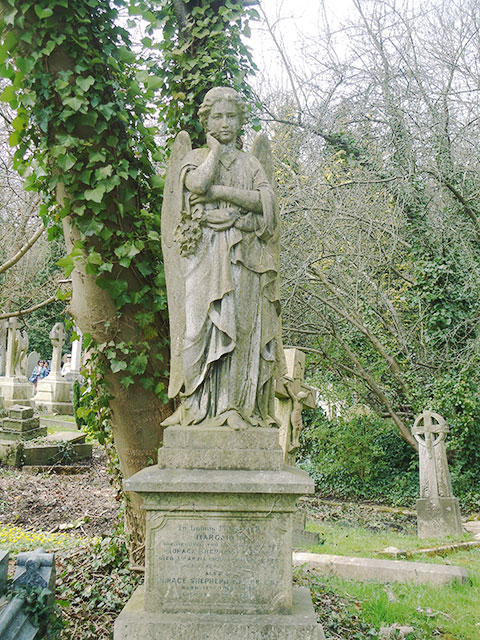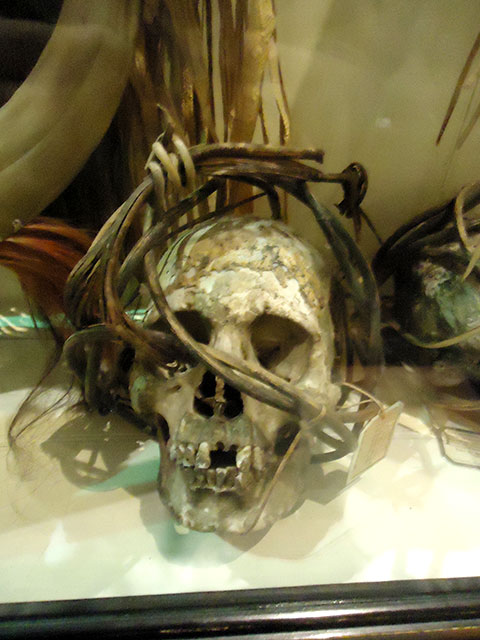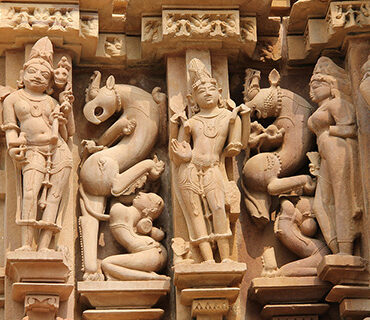Recently I visited and fell hopelessly in love with the Highgate Cemetery in London. It is one of the wildest, most famous and beautiful cemeteries in London. My friends could not understand my need to visit the cemetery as a tourist nor could they understand the satisfaction that I derived from it.
I must admit that there was a miniscule amount of doubt that I felt after my visit. This was because I had clicked numerous photos of beautiful, old, morose gravestones but I reasoned that these tours were actively promoted by the cemetery itself.

Highgate Cemetery. Photograph by Sangeeta Mulay.
I was therefore intrigued to learn that this kind of tourism has a name nowadays—travelling to places associated with death, pain, and suffering is known as dark tourism. The American Reporter in 2004 called it ‘the dirty little secret of the tourism industry’. Dark tourism can include anything from war tourism and graveyard tourism to holocaust tourism, prison tourism, and slavery tourism. This branch of tourism has steadily gained popularity over the years—so much so that an Institute of Dark Tourism has been established in Lancashire (England). Dr. Philip Stone, who founded the institute observes that dark tourists have existed since early times and this fascination for the macabre is clearly evident by the large numbers that turned up to watch public executions. Morgue tours too were extremely popular during Victorian times.
The Pitt Rivers Museum is a small, quirky museum located in the heart of Oxford, England. It has a total of 275,000 objects and just over 2000 of them are human remains or artefacts made with human remains. There are around 300 skulls in part or full and around 300 artefacts made with human hair and teeth. This museum chooses to display actual human shrunken heads—no mannequins or props here. The shrunken heads are from the region between Peru and Ecuador belonging to the Shuar and Achuar tribes. Enemy heads were usually taken in the olden days in order to capture souls and harness their power so that it could be used for the living tribes. Heads were shrunken using elaborate processes and rituals. Thankfully, this practice of shrinking heads ended in the ’60s. Several explorers collected these shrunken heads in the past and have donated them to the museum. Now, this is no shady museum frequented by weirdos—it is a renowned, award-winning one, affiliated to the University of Oxford. It is free and open to all. Children, especially, are often found exploring the myriad and mildly macabre exhibits displayed here. It is kept dark on purpose to preserve the displays. Exploring hidden corners of creaky drawers, with the help of the torches that are provided, is thoroughly encouraged here. Surely I am not alone in finding all this interesting in the extreme?

Skull of a dead enemy at the Pitt Rivers Museum. Photograph by Sangeeta Mulay.
India has its own share of dark tourism sites. The Jallianwalla Bagh in Amritsar, where the massacre of hundreds of innocents took place under the orders of Brigadier-General Dyer, has now become a memorial site. The walls still display bullet marks and the well in which people jumped to avoid the bullets has been preserved and protected inside the park. Thousands of visitors turn up to view this site of the massacre. The cellular jail or ‘Kaala Paani’ of Port Blair (Andaman) is another such dark site. This was the prison used during colonial times and several freedom fighters were exiled for life here. This jail has now become a memorial and attracts thousands of visitors. The cell in which Veer Savarkar was imprisoned has been preserved and is one of the prime attractions. It is interesting to note that both these sites deal with the atrocities committed during the British rule. It is with reverence that we Indians visit these sites—there is no element of guilt or the macabre here. The Dharavi slum in Mumbai on the other hand, raises some doubts. These slums have recently gained in popularity after the release of Danny Boyle’s Slumdog Millionaire and thousands of foreign tourists routinely flock here to gape at the poverty of the residents. But then, having indulged in dark tourism myself, who am I to point fingers at others?
The dark tourism destinations themselves often grapple with serious ethical dilemmas regarding the use and display of macabre sites for commercial purposes. The Pitt Rivers Museum, for example, gives an assurance on its website, that the displays that deal with human remains are respectful both to the living and the dead. The museum’s sole intention in displaying these is for the communication of educational and cultural information. Several of London’s beautiful old cemeteries actively encourage visitors to view the graves of some of the famous people buried there. The Highgate Cemetery conducts daily tours to generate revenues for the upkeep and repair of the cemetery. Several other cemeteries in London hold events for both children and adults, and visitors can be seen strolling, jogging, and even eating within the grounds.
Research conducted by the Institute of Dark Tourism observes that it is a mixture of voyeurism, fascination of the macabre, novelty, and curiosity that prompts tourists to visit these dark sites. Some tourists cite education as the main reason for their visit. Others have personal reasons like remembrance of a loved one for visiting these sites. A few seek to reinforce their cultural identity. My intentions were not that noble. It was the very unromantic combination of morbid curiosity and the unrelenting search for novelty that drove me. I have a suspicion that these interests are not healthy at all—a little like cheap pornography.
Like it or loathe it, dark tourism is thriving. For the budding dark tourists, here are links to some popular dark destinations around the world:
– Choeung Ek or the killing fields of Cambodia, where the Khmer Rouge carried out executions. [Link]
– The Pere-Lachaise Cemetery in Paris, one of the most visited cemeteries in the world with Jim Morrison, Oscar Wilde, Balzac, and Proust being buried there. [Link]
– London’s Highgate Cemetery, one of London’s wildest, beautiful and most famous cemeteries. Karl Marx and George Eliot are buried here. [Link]
– Auschwitz in Poland has what is left of the World War II concentration camps and is one of the five death camps constructed during the Nazi regime.
– The Pitt Rivers Museum in Oxford, England. [Link]
– The Hiroshima Peace Memorial Museum in Japan, which tells the story of Hiroshima and the damage caused by the bomb. [Link]









the cremation ghats of varanasi